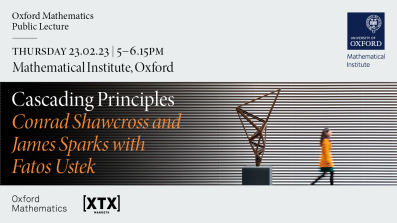1:30-2:15 Deborah Miori, CDT student, University of Oxford
DeFi: Data-Driven Characterisation of Uniswap v3 Ecosystem & an Ideal Crypto Law for Liquidity Pools
Uniswap is a Constant Product Market Maker built around liquidity pools, where pairs of tokens are exchanged subject to a fee that is proportional to the size of transactions. At the time of writing, there exist more than 6,000 pools associated with Uniswap v3, implying that empirical investigations on the full ecosystem can easily become computationally expensive. Thus, we propose a systematic workflow to extract and analyse a meaningful but computationally tractable sub-universe of liquidity pools.
Leveraging on the 34 pools found relevant for the six-months time window January-June 2022, we then investigate the related liquidity consumption behaviour of market participants. We propose to represent each liquidity taker by a suitably constructed transaction graph, which is a fully connected network where nodes are the liquidity taker’s executed transactions, and edges contain weights encoding the time elapsed between any two transactions. We extend the NLP-inspired graph2vec algorithm to the weighted undirected setting, and employ it to obtain an embedding of the set of graphs. This embedding allows us to extract seven clusters of liquidity takers, with equivalent behavioural patters and interpretable trading preferences.
We conclude our work by testing for relationships between the characteristic mechanisms of each pool, i.e. liquidity provision, consumption, and price variation. We introduce a related ideal crypto law, inspired from the ideal gas law of thermodynamics, and demonstrate that pools adhering to this law are healthier trading venues in terms of sensitivity of liquidity and agents’ activity. Regulators and practitioners could benefit from our model by developing related pool health monitoring tools.
2:15-3:00 Žan Žurič, CDT student, Imperial College London
A Random Neural Network Approach to Pricing SPDEs for Rough Volatility
We propose a novel machine learning-based scheme for solving partial differential equations (PDEs) and backward stochastic partial differential equations (BSPDE) stemming from option pricing equations of Markovian and non-Markovian models respectively. The use of the so-called random weighted neural networks (RWNN) allows us to formulate the optimisation problem as linear regression, thus immensely speeding up the training process. Furthermore, we analyse the convergence of the RWNN scheme and are able to specify error estimates in terms of the number of hidden nodes. The performance of the scheme is tested on Black-Scholes and rBergomi models and shown to have superior training times with accuracy comparable to existing deep learning approaches.


